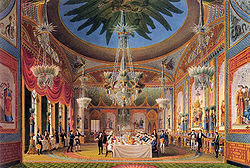Buildings and structures
Buildings completed


- Piazza del Popolo, Rome, by Giuseppe Valadier, completed.
- Saint David's Building, the original home of St David's College, Lampeter, Wales, by Charles Cockerell.
- Reconstruction and new prison buildings at Chester Castle, England, by Thomas Harrison.
- St Pancras New Church, London, by William and Henry William Inwood.
- Kalupur Swaminarayan Mandir, Ahmedabad, British Raj.
- Assembly Rooms, Aberdeen, Scotland, by Archibald Simpson.
- Second Chestnut Street Theatre, Philadelphia, United States, by William Strickland.
- Main building of Government Palace (Finland) in Helsinki Senate Square, by Carl Ludvig Engel.
- Façade of Register House, Princes Street, Edinburgh, Scotland, by Robert Reid. [1]
- Reconstruction of Royal Pavilion, Brighton, England by John Nash.
- Yelagin Palace, Saint Petersburg, by Carlo Rossi.
- Cartland Bridge, Scotland, by Thomas Telford. [2]
- Pont de pierre (Bordeaux), by Jean-Baptiste Billaudel and Claude Deschamps. [3]
- Aban Palace, Kumasi, a project of Asantehene Osei Bonsu.